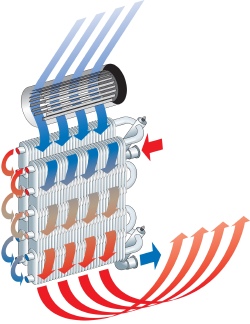Flexible heat emission

How informed are you about the potential benefits of fan convectors as heat emitters in wet central-heating systems. Jim Bennett of Smith’s Fan Convectors highlights a host of benefits.
Despite being one of the most flexible heat emitters available to commercial specifiers and contractors, fan convectors are often overlooked for heating systems. Hydronic by design and compatible with all kinds of wet central-heating systems, including those with air or ground source heat pumps, fan convectors provide heating solutions that are easy to install and simple to operate for many industrial and commercial applications. In this article I will explain why.
A fan convector functions by means of a heat exchanger and a small electric fan. The heat exchanger is connected to a standard 2-pipe central heating system which passes hot water through the heat exchanger, transferring its heat to the aluminium fins. The fan draws in cooler air which is heated as it moves over the heat exchanger and is then expelled gently back into the room by the same fan.
Unlike a conventional panel radiator, the fan convector provides a more even temperature spread and much faster warmth. The small fan means that the heat produced is distributed using forced, rather than natural, convection — making it far more responsive to thermostatic controls.
 |
| By circulating air around a room, fan convectors avoid heat being lost through the wall behind them. |
The commercial applications this type of heating lends itself to are easily apparent.
Specifying fan convectors rather than panel radiators brings cost savings to the end user because they can be timed to switch on with much shorter lead times. Radiators require much longer lead times to come to temperature and then warm a room. Even then, a good 10% of their heat is lost heating the wall behind them. In our own factory tests, we have proven that a space can be heated from a starting temperature of 12°C to a comfortable 25°C within 15 minutes. The inherent design of the fan convector means that they use a mere 5% of the water content of an equivalent output radiator, making them significantly more efficient.
With the heat-output switch left on either normal or boost position, a fan convector will come on and off automatically with the central-heating system. As they use the same pipework, they can be controlled individually, as a group or linked to the building’s control system, as required.
Fan convectors are compatible with all types of wet central-heating systems and function equally efficiently, whether connected to a conventional boiler or renewable technology, such as biomass boilers or ground or air source heat pumps. In line with EU legislation, the leading fan convectors will also incorporate the latest EC motor technology which can result in running cost savings as high as 80% to deliver heat quickly, efficiently and effectively.
The other great advantage of specifying a fan convector is that they can be sited anywhere to suit the overall design and build of the commercial unit. They can sit low on a wall like a radiator, and because they do not rely on natural convection to produce heat, they can be positioned almost anywhere else. From installations high on a wall, on a ceiling, above doorways or in kitchen plinths, they can also be recessed into a wall or ceiling or concealed completely.
The latest generation of fan convectors come in different styles to suit their environment and are sleek and quiet. We find the contractors we work with often favour them for installations in churches and other places of worship because they can be timed to come on minutes before a service, rather than the hours required with radiators.
In buildings that have often been converted into a church, rather than purpose built, fan convectors enable the space to be used for a variety of activities at different times of day because they will switch themselves off when they reach the required room temperature. LST (low surface temperature) surfaces means that fan convectors are suitable for use around elderly and young people and children. In older churches, where the heat loss can be significant because of their ancient stone structures and design, fan convectors provide a wonderful solution to cold Sunday services compared to struggling radiators that simply cannot produce sufficient heat in time and at the correct quantity to keep parishioners warm.
 |
| The way fan convectors deliver heat make them well suited to old buildings such as churches. |
Fan convectors are often favoured by housing associations and local authorities, which may choose them for living rooms or kitchens and bathrooms. In light-commercial settings, almost any space may feature a fan convector. Office space, doctors’ surgeries, care homes or nurseries can all benefit, and with businesses seeking ways to reduce their carbon footprint and overheads, fan convectors can be a useful means of offering both..
So in total we have at least five benefits offered by fan convectors.
• Easy to install.
• Flexible to position.
• Lower heating bills.
• Easy to use and control.
• Very quick to heat up.
As a British manufacturer, we are working hard to develop the product options for the commercial user and see huge potential for fan convectors across the commercial market.
Jim Bennett is sales and marketing director with Smith’s Fan Convectors.







